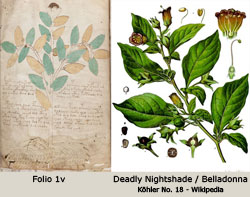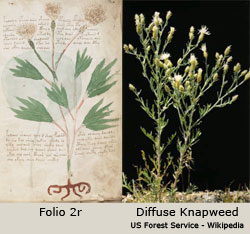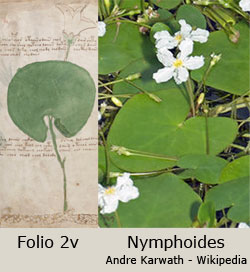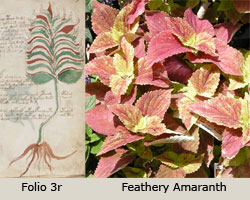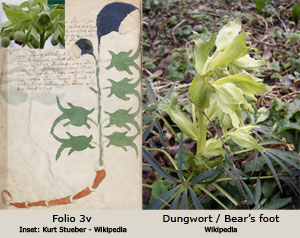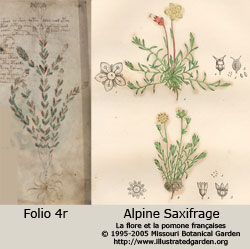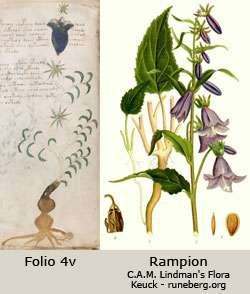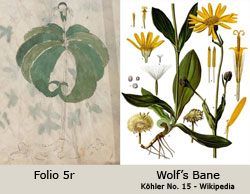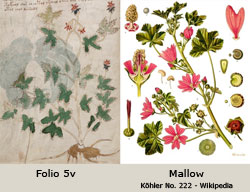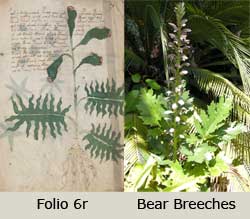The Voynich Botanical Plants
Folio 1v, Deadly Nightshade or Belladonna (Atropa belladonna), is an extremely toxic and hallucinogenic plant, native to Europe and North Africa. It is a low growing shrub with dull green leaves, purple bell-shaped flowers, and black berries. All parts of belladonna are toxic including its rough thick brown root. The plant contains the alkaloid atropine, a drug used by ophthalmologists to dilate the pupils of the eye. Note: this plant was identified by Petersen.
Folio 2r, Diffuse Knapweed (Centaurea diffusa), is native of Greece and Asia Minor. This weed has a long taproot, and pale-green alternate leaves that are deeply divided into lobes, measuring 1 to 3 inches in length. The single, upright stem produces several spreading branches that end with pink or white thistle-like flowers. During the Middle Ages knapweed had a reputation for curing wounds and was an ingredient in a fourteenth century ointment called ‘salve.’ This folio could also be represented by spotted knapweed (Centaurea biebersteinii), also native to Eurasia.
Folio 2v, Nymphoides, is an aquatic plant native to Europe and Asia. The small, five-lobed flowers are held above the surface of the water and the roots are embedded in the mud at the bottom of the pond, while the large kidney shaped leaves float on the water surface.
Folio 3r, Feathery amaranth (Celosia argentea), is a widespread weed throughout tropical Africa. It is primarily used in Africa as a leafy vegetable for soups, sauces, or stews. Celosia has plume-like flowers ranging in color from dark-crimson to orange and golden-yellow making it a useful bedding and pot plant (Prota Database). Another possibility for Folio 3r is croton (Codiaeum variegatum), a native of Southern Asia.
Folio 3v, Dungwort or Bear’s foot (Helleborus foetidus) is a small, herbaceous shrub native to Western Europe. It has a thick, succulent stem; palmately compound leaves; drooping green, cup-shaped flowers; and short rhyzomes for roots. All parts of the plant are poisonous. The leaves emit a bad smell when crushed. A good photograph of the shrub can be viewed at the BelleWood Gardens Web site.
Folio 4r, Alpine Saxifrage (Saxifraga cespitosa), is a species of edible plant found in Northern temperature zones. It has a taproot, and the leaves are opposite and evenly distributed along the trailing stems. At the beginning of each growing season the old leaves turn orange and die (McJannet C.L., Aiken S.G., Dallwitz M.J., Gillespie L.J. and. Consaul L.L.). The flowers are single and purple. The name, Saxifrage, comes from the Latin for rock-breaker because of its apparent ability to split rocks. As a result, it was prescribed as a herb for breaking up bladder and gallstones.
Folio 4v, Rampion (Campanula rapunculus), is found in the woods and meadows of Europe and Asia. This biennial plant is grown in France, Germany, and Italy for its turnip-like roots and leaves which are eaten in salads. The stars may represent an empty calyx on the long stem with linear leaves and five-lobed, purple, bell-shaped flowers. There is an Italian tradition that the possession of a rampion excites quarrels among children and the story of Rapunzel is related to the theft of rampions from a magician’s garden.
Folio 5r, Wolf’s bane (Arnica montana), is a European flowering plant with large, yellow, daisy-like flowers. The root is a curved rhizome with brittle, wiry rootlets. The stem is erect and generally not branched. Ovoid, leathery leaves at the base of the stem are arranged in a rosette. At the apex of the stem leaves are opposite. Tincture of Arnica has been used for external application to sprains, bruises, and wounds, and as a paint for chilblains when the skin is unbroken. Repeated applications may produce severe inflammation. Due to its toxic properties it is seldom used internally.
Folio 5v, Mallow (Malva sylvestris), is native to Europe and North Africa. The pink-red flowers are used as a natural dye. The perennial roots are thick, long, and tapering. The flowers, leaves, and roots are edible and the Romans considered dishes made from the plant as a delicacy. The plant was once used as a sweetener in marshmallow foods. The emollient properties of the plant are used to soothe coughs and digestive problems. (Grieve, M.,)
Folio 6r, Bear Breeches (Acanthus mollis), is native to Southern Europe and one of the earliest garden plants to be cultivated. It has a cluster of deeply-lobed, dark-green, basal leaves. The purple-white flowers with green bracts are produced on a stem growing above the leaves. The plant propagates from tubers. Romans used scrolls and the leaves from the Acanthus plant to decorate the Corinthian columns.
